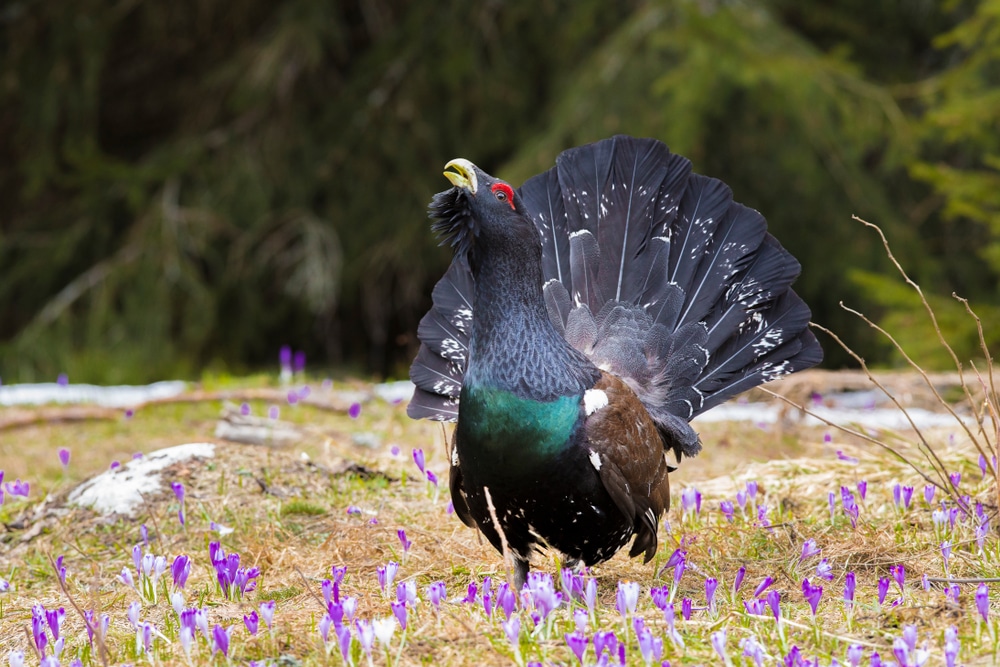Capercaillie numbers at critically low levels, national survey results reveal
The sixth national Capercaillie survey has estimated there are now only 542 individual Capercaillie, a reduction of around half putting the remnant UK population at real risk of extinction.
Capercaillie are the world’s largest grouse and populations range from Iberia in the southwest of Europe to Siberia and Mongolia in Central Asia in temperate and boreal forest. Weighing in at around four to five kilos, it looks like a much larger version of its distant cousin the Black Grouse. The UK population is only found in Scotland, mostly in Scots Pine forests that have a rich growth of blaeberry on the forest floor. The males are known for their communal leks in the spring where they try to attract females, by fanning out their tail feathers, and making a remarkable series of clicking and popping noises. Leks can often lead to fights between the males as they compete for a mate. The current population are descendants of birds reintroduced in Scotland in the 1830s after the original population went extinct during the previous century.
Scotland’s Capercaillie population was surveyed over the winter of 2021/22. Observers recorded sightings of the birds as well as signs of their presence such as feathers and droppings. The survey found that the Cairngorms National Park is estimated to have 85 percent of the total population.

Numbers have been declining since the third national survey of 2003/04 when there were estimated to be about 2000 birds. The latest results represent the largest drop in numbers since 2000, and the first time they have dipped to fewer than 1000 putting the population at a critically low level.
Nick Wilkinson, Conservation Scientist at RSPB Scotland said: “This up-to-date estimate of Capercaillie numbers reveals just how vulnerable the population in Scotland is. Previous surveys have seen numbers fluctuating between around 1000 and 2000 birds so it’s really worrying that the results from last winter indicate there are only an estimated 542 individuals remaining now. These results will help focus efforts on where action should be targeted to help Capercaillie by identifying their strongholds and where the most impact can be made for them.”

The factors causing the decline are complex ranging from cold, wet spring weather impacting the fitness of female birds before the breeding season and affecting chick survival, and predation and disturbance. While habitat is continually being extended and enhanced, it remains fragmented in places and this work takes a much longer period of time to make a difference.
If the population continues to decline, the species could be lost to Scotland within two to three decades. Following a thorough review of the scientific evidence, the sub-committee advised that current breeding success is too low to allow recovery of the population. It suggested that interventions that improve the survival of eggs and young chicks are especially important including diversion feeding and creation of refuges around hotspots to minimise disturbance.
Making habitats more resilient is also one of the key areas that organisations and land managers are focusing on to help Capercaillie. In Scotland, the forest habitat favoured by the birds is fragmented and dispersed. It also reported that the survival of adults would be enhanced with more work to mark or remove deer fences, which can cause injury or death to birds in flight.

The Cairngorms Capercaillie Project, which began in 2018, supports community-led action in the Cairngorms National Park to help the birds such as increasing awareness of their plight and working with recreational users such as mountain bikers and dog walkers to reduce disturbance in sensitive areas. The project is also waiting on the results of a study into the genetic diversity of the population within the National Park and whether the gene pool needs to be expanded.
The Capercaillie is listed on Schedule 1 of the Wildlife & Countryside Act 1981. This makes it illegal to intentionally disturb birds when nesting. Viewing during the breeding season should only be undertaken under licence from NatureScot. Without a licence, Capercaillie leks should not be visited at all during the critical March-May period. Sadly, disturbance from birdwatchers and photographers trying to get too close to leks is still a problem. Please follow the Code of Practice devised by the RSPB.
If you’re aware of people acting irresponsibly and causing disturbance to Capercaillie please report the incident to a Wildlife Crime Officer by calling Police Scotland on 101.

